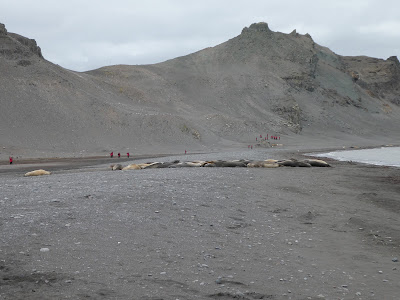During the night the ship has turned north toward the South Shetland Islands chain. Our morning expedition will be at Deception Island.
The island is a very rare geological phenomenon - a flooded volcanic basin known as a caldera. It is formed by the collapse of the central part of a volcano.
And cross the caldera to Telefon Bay where we then go to the shore on the zodiacs. The foggy weather mirrored the dark history that besieged this volcanic caldera over the last two centuries.
Whaler's Bay, one of the first beaches inside Deception Island, was once Antarctica's main whaling hub. The Norwegians and British processed an estimated 86,000 whales from the Southern Ocean. Luckily, most of those species of whales are now making a slow comeback from their near extinction.
We set off on a hike towards the rim of a recent volcanic crater to take in a bird's eye view of the surroundings.
A good view was not possible through the thick fog.
The orange chain was a reminder to keep back from the edge...
It was a deep crater.
Couldn't see very much due to the heavy, wet fog.
We headed back down to the beach and watched the Chinstrap Penguins wander to and fro.
And as we returned to the ship and sailed out of Deception Island, the sun started to come out.
The ship now headed to our last destination in the Antarctic - Walker's Bay on Livingston Island.
Once there, we disembarked the ship one last time for a walk along another volcanic beach.
We gathered around a display that included petrified rocks from millions of years ago,
and plant fossils.
and whale bones possibly 100 years old.
There were groups of Southern Elephant Seals on the beach, all huddled together and going through their molt.
They come ashore and stay on the beach for 3 weeks during the molt, and then return to sea for another year.
Brown skuas birds were scanning the beach up and down for something to snack on. They flew fast but I actually caught one on my point and shoot camera.
I'm afraid this was a recent snack.
The penguins didn't seem bothered by these giant Elephant Seals.
Most of them seemed to be sound asleep.
Occasionally they would raise a flipper
Then it was time to head back to the ship and take one last look at this beautiful white continent. What an experience we have had!
By the next morning we were well on our way through the Drake Passage. The seas were relatively calm, but that began to change after lunch. There was a storm brewing off the west coast of South America and the captain was speeding us along in order to reach the protection of the Beagle Channel.
Here, Expedition Team Leader, Claudia, was explaining the weather we could expect.
During our crossing of the Drake Passage, the seas became increasing rough, but not bad. Probably a mild "Drake Shake". The Expedition Team presented more lectures about Antarctica, its geology, history of exploration, marine life, sea birds and climate change.
On Tuesday, January 7, we awoke to "Land Ahoy"--the southern tip of South America and would soon enter the Beagle Channel as we made our way back to Ushuaia.
The day was spent with more "Learning and Discovery" presentations and wildlife watching as we approached the entrance to the Beagle Channel.
Oh, and we also had to start packing up our luggage. We would be disembarking the ship in the morning.
We shared our last dinner on the ship with our "travel buddies", Ken and Margaret and also Sharon and Richard. We had met Sharon and Richard on our Patagonia trip in January, 2018. It was fun to get reacquainted with them on this voyage.
The food was always very good on the ship. For our last dessert, the chefs made Baked Alaska and paraded through the dining room with lots of appreciative cheers from all us travelers.
In the morning we bid our final farewells to the Expedition Team and ship staff and crew.
We had shared incredible moments in one of the most remote corners of the world.
We flew back to Buenos Aires where we said goodbye to several of our group members who would not be joining us on the post-trip to Iquazu Falls.
But for us, the trip is not over. We return to one of our favorite waterfalls, Iguazu Falls. It's not one waterfall....there's 275!!
To continue reading, scroll down and click on "Newer Post".






























No comments:
Post a Comment